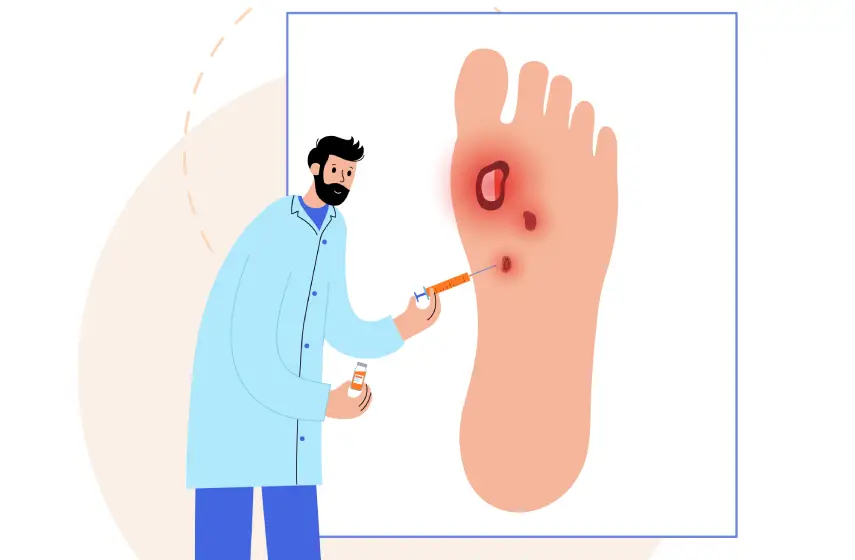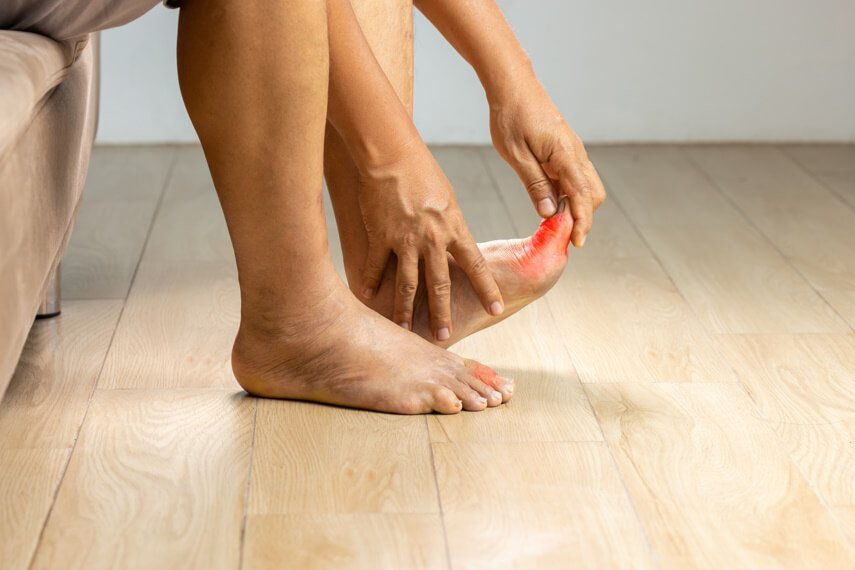Common Foot Infections: Causes, Symptoms, and Effective Treatments
IOur feet carry us through life, yet we often overlook their care until a problem arises. Foot infections are more common than most people think and can affect anyone, especially those with underlying conditions like diabetes. These infections can range from mild fungal conditions to severe bacterial complications that require immediate medical attention.
Whether it’s an itchy rash between the toes or swelling and warmth on the foot, understanding the root cause and knowing how to manage the issue early can save you from pain, complications, or even hospitalisation. At Surat Diabetic Foot & Ulcer Clinic, we encounter numerous patients facing foot problems that could have been avoided with timely care and awareness.
In this blog, we’ll explore four of the most common foot infections: Athlete’s Foot, Cellulitis, Fungal Toenail Infection, and Diabetic Foot Infections. Each section outlines the causes, symptoms, treatment options, and preventive steps. This easy-to-understand guide is especially helpful for those
IOur feet carry us through life, yet we often overlook their care until a problem arises. Foot infections are more common than most people think and can affect anyone, especially those with underlying conditions like diabetes. These infections can range from mild managing diabetes or chronic foot conditions.
Athlete’s Foot
Causes
Athlete’s Foot, or tinea pedis, is a common fungal infection caused by dermatophytes. These fungi thrive in warm, damp environments such as communal showers, swimming pools, and sweaty socks. People who wear tight shoes or who frequently keep their feet enclosed for long periods are more prone to this infection.
Symptoms
Early signs include redness, itchiness, and a scaly rash that typically starts between the toes. You may also notice cracking, flaking skin and a burning sensation. The infection can spread to other areas of the foot or even to the hands.
Treatments
Athlete’s foot treatment includes antifungal creams, powders, or sprays that are easily available over the counter. For more persistent infections, a doctor may prescribe oral antifungal medications. At Surat Diabetic Foot & Ulcer Clinic, we offer customised treatment plans, especially for patients with diabetes, to avoid complications.
Prevention Tips
- Keep feet clean and dry
- Change socks daily
- Avoid walking barefoot in public showers
- Use antifungal powder if you sweat excessively
Cellulitis
Causes
Cellulitis is a serious bacterial foot infection often caused by Streptococcus or Staphylococcus bacteria entering through a cut, wound, or cracked skin. It spreads rapidly and can lead to severe complications if untreated.
Symptoms
Cellulitis symptoms include redness, swelling, warmth, and pain in the affected area. Fever and chills may also accompany the infection. The skin may appear tight, glossy, and inflamed.
Treatments
Immediate medical attention is required. Treatment usually involves oral or intravenous antibiotics, depending on the severity. At Surat Diabetic Foot & Ulcer Clinic, we closely monitor patients with compromised immune systems or diabetes, as they are more vulnerable to such infections.
Prevention Tips
- Treat even minor cuts or abrasions promptly.
- Maintain foot hygiene.
- Moisturise dry, cracked skin to prevent entry points for bacteria.
- Manage underlying conditions like diabetes.
Fungal Toenail Infections
Causes
Also known as onychomycosis, fungal toenail infections occur when fungi invade the nail bed. Moisture, poor foot hygiene, and wearing non-breathable shoes contribute to the risk.
Symptoms
Common signs include yellow or brown discolouration, thickening of the nail, brittleness, and sometimes foul odour. The nail may lift from the nail bed in severe cases.
Treatments
Topical antifungal nail lacquers or oral antifungal medications are the standard options. Laser treatments are also available. Early diagnosis helps avoid complete nail loss. At Surat Diabetic Foot & Ulcer Clinic, we ensure safe trimming and debridement, especially for diabetic patients, minimising risk.
Prevention Tips
- Keep nails trimmed and dry.
- Avoid sharing nail clippers or shoes.
- Disinfect tools used for pedicures.
- Wear breathable footwear.
Diabetic Foot Infections
Causes
Diabetic Foot Infections develop due to a combination of high blood sugar levels, poor circulation, and nerve damage. Minor wounds may go unnoticed, eventually leading to serious infections.
Symptoms
Warning signs include swelling, warmth, redness, pus discharge, foul smell, or even blackened tissue due to necrosis. These can lead to ulcers, gangrene, or amputations if ignored.
Treatments
Early intervention is crucial. Treatment involves controlling Blood Sugar, antibiotics, wound cleaning, and specialised footwear or orthotics to offload pressure. Advanced infections may require surgical debridement or even hospitalisation. At Surat Diabetic Foot & Ulcer Clinic, we specialise in the treatment of diabetic feet using advanced wound care techniques and custom diabetic footwear solutions.
Prevention Tips
- Inspect feet daily for cuts or blisters.
- Wear properly fitted, cushioned shoes.
- Keep blood sugar levels under control.
- Visit a podiatrist regularly, even for minor concerns.
Conclusion & Call-to-Action
Foot infections might start small but can turn severe in no time, especially for diabetic individuals. Whether it’s the itch of a fungal infection or the swelling from cellulitis, prompt attention and proper care are the keys to healthy feet. The good news? Most foot infections are preventable with good hygiene, early detection, and a proactive healthcare approach.
If you're experiencing discomfort, unusual symptoms or have diabetes, don’t wait. Trust the experts at Surat Diabetic Foot & Ulcer Clinic. Our experienced team is dedicated to providing specialised care, from Athlete’s foot treatment to managing complex Diabetic Foot Infections. With state-of-the-art equipment and compassionate doctors, we help you walk towards better health, step by step.
Book your consultation today and take the first step in preventing and managing foot infections effectively.
FAQs
What are the most common foot infections?
Athlete's foot, fungal toenail infections, cellulitis, and diabetic foot infections are among the most common.
What are 7 common foot problems?
Corns, calluses, bunions, plantar fasciitis, ingrown toenails, blisters, and fungal infections.
What does a bacterial infection look like on the foot?
Redness, swelling, warmth, tenderness, and sometimes pus or drainage. It may resemble a painful rash.
What is the common disease of the foot?
Fungal infections like athlete’s foot and nail fungus are very common.
How to cure a foot infection?
Depending on the type, treatments include antifungal or antibiotic medications, keeping the foot clean and dry, and seeking timely medical care.
What is the most common type of foot?
Flat feet are considered the most common foot structure globally.
What kills foot fungus fast?
Prescription antifungal creams or oral medications work effectively. Keeping the area dry is also key.
How to relieve foot pain in 30 seconds?
Gentle stretching, rolling the foot on a cold water bottle, or applying a cold compress may provide quick relief.
How to heal blisters on feet overnight?
Clean the area, apply an antibiotic ointment, cover with a bandage, and keep it dry to promote healing.






.jpg)

